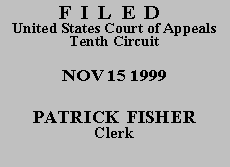

| LYMON WILLIAMS,
Plaintiff-Appellant, v. KENNETH S. APFEL, Commissioner, Social Security Administration, Defendant-Appellee. |
|
Plaintiff appeals from an order of the magistrate judge(1) affirming the Commissioner's decision to grant social security benefits from May 6, 1993 through August 17, 1994, and to deny benefits thereafter. The Commissioner determined plaintiff had been disabled during this closed period by back injury and spinal surgery, but, after significant post-operative improvement, was then able to perform sedentary work and, therefore, was no longer disabled under the applicable medical-vocational guidelines. We examine the record as a whole to determine whether the Commissioner's decision is supported by substantial evidence and adheres to correct legal standards. See Shepherd v. Apfel, 184 F.3d 1196, 1199 (10th Cir. 1999). The scope of our review, however, is limited to the issues properly preserved and presented on appeal. See Berna v. Chater, 101 F.3d 631, 632-33 (10th Cir. 1996). Guided by these principles, we affirm the Commissioner's decision for substantially the reasons stated by the magistrate judge.
Plaintiff concedes that the record establishes "medical improvement related to the ability to work," Appellant's Op. Br. at 9, a critical prerequisite to the finding of nondisability in a closed period case such as this, see Shepherd, 184 F.3d at 1200-01. He challenges, instead, the subsequent determination that he was capable of sedentary work. Acknowledging that his treating physician released him in March 1994 with restrictions fully compatible with sedentary work, see App. Vol. II, at 194, 195, plaintiff argues that "evidence subsequent to that date" indicated that he "was more disabled than his physicians had originally believed." Appellant's Op. Br. at 16. However, later medical records do not retract or question the March 1994 work release. On the contrary, after a lumbar myelogram and CT scan in May 1995, which found "no significant radiographic abnormality" and "ordinary postop appearance," App. Vol. II, at 254-55, plaintiff's treating physician continued to recommend job retraining for sedentary work, see id. at 285.
Plaintiff also objects to the administrative law judge's observation that "recuperation normally takes a year from the date of surgery," id. at 19, arguing that "the ALJ's personal opinion that [plaintiff] should have recovered from his surgery after a year cannot serve as substantial evidence [that] . . . he had in fact done so." Appellant's Op. Br. at 16. We agree with plaintiff that "the ALJ overstepped his bounds into the province of medicine" with this unsubstantiated presumption of a one-year recovery period, Miller v. Chater, 99 F.3d 972, 977 (10th Cir. 1996), but we agree with the magistrate judge that the error only benefitted plaintiff, providing a "gift" of an additional five month's presumptive disability, from his actual release for sedentary work in March 1994 until August 18, 1994,(2) see App. Vol. I at 16-17. In short, substantial evidence supports the finding of nondisability on August 18, 1994, and the fact that this same evidence should have led to a finding of nondisability several months earlier does not further plaintiff's position on this appeal.
Finally, plaintiff challenges the ALJ's determination that his allegations of pain were not fully credible. The ALJ made this determination on the basis of a whole host of relevant considerations. See App. Vol. II at 18-19. Plaintiff contends two of these, involving an inconsistency in his testimony and a gap in his treatment, were mistakenly weighed against him. The former concerned his ability to sit. The ALJ noted plaintiff had given three different estimates of how long he could remain seated: first 15-20 minutes, then 30 minutes, and finally 1-2 hours. See App. Vol. II, at 328, 335. Plaintiff argues he explained to the ALJ that the first estimate was for sitting "before having to move around a bit" and the second was for sitting "before having to actually get up out of his seat." Appellant's Op. Br. at 18. However, the major discrepancy here, between these initial two estimates and the last, remained unexplained and was properly relied on by the ALJ.
Plaintiff contends the ALJ erred in stating that he "was not credible because he had gone for more than a year without seeking medical treatment for his back." Appellant's Op. Br. at 18. This objection is simply misdirected. The ALJ referred to a gap in actual medical treatment for back problems, not a failure on plaintiff's part in seeking such treatment. See App. Vol. II, at 18. In sum, ample evidence supports the ALJ's assessment of credibility, to which we properly defer. See generally Kepler v. Chater, 68 F.3d 387, 391 (10th Cir. 1995); Casias v. Secretary of Health & Human Servs., 933 F.2d 799, 801 (10th Cir. 1991).
The judgment entered by the magistrate judge of the United States District Court for the Northern District of Oklahoma is AFFIRMED.
Entered for the Court
Circuit Judge
*. This order and judgment is not binding precedent, except under the doctrines of law of the case, res judicata, and collateral estoppel. The court generally disfavors the citation of orders and judgments; nevertheless, an order and judgment may be cited under the terms and conditions of 10th Cir. R. 36.3.
1. The parties consented to proceed before the magistrate judge pursuant to 28 U.S.C. § 636(c)(1). Hence, our appellate jurisdiction arises under § 636(c)(3) and 28 U.S.C. § 1291.
2. In fact, plaintiff's surgery took place on September 9, 1993, so the August 18, 1994 "anniversary date" used by the ALJ is itself evidently a mistake. The discrepancy appears to have been fostered by a handwritten notation on the first page of the exhibit to which the ALJ referred, which, because it included records leading up to the surgery, said "8-18-93 to 9-13-93." App. Vol. II, at 217.